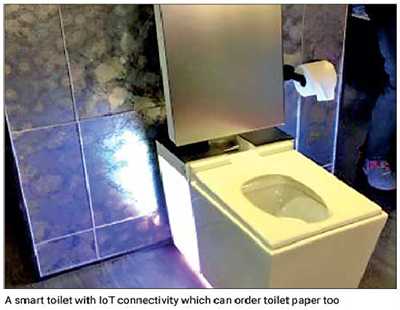Tuesday Nov 04, 2025
Tuesday Nov 04, 2025
Thursday, 21 March 2019 00:00 - - {{hitsCtrl.values.hits}}
The Budget speech of 5 March positioned sanitary facilities or rather the absence across the country to a new height, bringing attention to a subject much less talked about.
 To repeat what the Minister of Finance stated: “Mr. Speaker, in spite of the country reaching middle income status, and in spite of millions of rupees being invested in sophisticated expressway projects, city developments, etc., almost 260,000 houses in the country are without sanitary facilities. For example, the Hambantota District, which saw a splurge of mega projects in the form of California-style highways, Chinese-style conference halls and sports stadiums, has over 15,000 people without even the most basic of sanitary facilities. As such, we will provide all such houses in the country with sanitation facilities within two years, benefitting almost one million of our citizens. Many bus terminals and railway stations’ sanitary facilities are also in an atrocious condition. Therefore, funds will be allocated to improve them. Such facilities will be provided for men, women and those with special needs. Once built, the private sector will be invited to maintain these facilities.”
To repeat what the Minister of Finance stated: “Mr. Speaker, in spite of the country reaching middle income status, and in spite of millions of rupees being invested in sophisticated expressway projects, city developments, etc., almost 260,000 houses in the country are without sanitary facilities. For example, the Hambantota District, which saw a splurge of mega projects in the form of California-style highways, Chinese-style conference halls and sports stadiums, has over 15,000 people without even the most basic of sanitary facilities. As such, we will provide all such houses in the country with sanitation facilities within two years, benefitting almost one million of our citizens. Many bus terminals and railway stations’ sanitary facilities are also in an atrocious condition. Therefore, funds will be allocated to improve them. Such facilities will be provided for men, women and those with special needs. Once built, the private sector will be invited to maintain these facilities.”
The Budget speech did not mention schools with their own sanitation problems. Hopefully that is included too as the presence of decent sanitation facilities in any environment seriously boost productivity.
Ken Blanchard wrote in ‘Raving Fans’ that the first thing to be checked in an organisation should be its toilet facilities. The Budget was quite generous with the allocation – Rs. 5 billion – when compared to some other allocations though if you identify per unit allocation with the numbers indicated – Rs. 19,000 on average per house – the allocation may find a bit more wanting!
It is important to indicate that the enterprise innovation program which when implemented has the potential to drive our enterprises to a different level has only been allocated Rs. 50 m! However, I am definitely for ensuring the sanitation facilities available as a first step for a society.
Ignoring meeting the basic functional support by the populace can have serious consequences especially in cities as the British found to their expense on their way to the First Industrial Revolution. You will be interested to read records from London, which read: “An ill-fated labourer by the name of Richard the Raker fell into a cesspool and literally drowned in human shit.”

Night soil men were common in London collecting from cess pits. Progress as we know is made by us being creative and executing creative thoughts and that is why Englishmen who came up with the flushed toilet system and with valve systems are today in the Hall of Fame of inventors – John Haringhton, Thomas Crapper, Albert Giblin. Such implementations prevented subsequent generations facing the problems Richard faced.
In our own land we know that sanitation systems prevailed from the very beginning as Anuradhapura era temples have better waste management systems and the structures exist to date. However, as the Budget speech reminded us, we appear to have gone backwards while other nations have moved up the ladder.
Success lies in delivery
Considering the emphasis made and the allocations, there is no question sanitation was the order of the day and one can dare say that this issue will touch almost all the voters and the future ones alike. The success however is upon delivery and then only will relief be expressed and appreciated with a cross on the ballot paper.
Definitely with the numbers expressed and the grim situation described the delivery upon completion would be very much visible and felt. However, the speech mentioned in meeting facilities in public places, the State would carry out the building process and subsequently the private sector would be called into manage. There was no clear indication of current concurrence over this by any potential private sector entity at least in principle.
 The issue is that time is of the essence – you just cannot hold it any more – and the public procurement system implementing this proposal speedily across the country sparing no bus stand, across State, provincial and local administration mechanism and then entering into a public-private partnership is quite difficult to contemplate.
The issue is that time is of the essence – you just cannot hold it any more – and the public procurement system implementing this proposal speedily across the country sparing no bus stand, across State, provincial and local administration mechanism and then entering into a public-private partnership is quite difficult to contemplate.
I do not want to be so pessimistic over an important proposal of this nature. I really say this needs to happen and one must deliver too and then can say a particular universal need has finally been answered and an issue had been finally put to rest. I know there are staunch supporters of the public procurement system who always rushed to its defence saying that it is not the mechanism that is faulty but the implementation. However, I am not at all a supporter of the whole system after witnessing and experiencing decades of inefficiency and nonfulfillment.
Day after day one witnesses science and technology shunned and archaic concepts propagated as procurement methodology. How this can be defended is something I cannot answer or comprehend. Even if the process is effective, the stench of corruption, which always is proportional to the amounts involved, is something that remits a relook at the process as well as the implementation.
Sanitation service provision proposal should not suffer a similar fate. The combined stench of a process malfunction would be too much to bear across the breadth and the width of the country. There are many types and mechanisms for providing the service intended. How the money allocation had been made is not clear but the usual bugbear of public sector – the audit question – may not arise why the least cost option of pit latrines everywhere was not provided!
Sanitation is a global issue
If someone thinks that it was wrong to focus on toilets in the Budget, that is wrong. Sanitation is captured in SDG 6 and we know that it is a global issue. Toilets also utilise resources and when we use toilets we use copious amounts of water in old designs – six litres to flush away perhaps few millilitres of stuff. Imagine the electricity and water consumed unnecessarily and all the costs.
When everyone starts flushing and quite a few times over a day that amounts to a significant expenditure and an environmental burden. If not properly carried out, a life-threatening risk to a person such as Richard the Raker has now been transformed into a resource sucking operation.
 That is why the toilet has received the attention of one of the world’s richest men – Bill Gates. He believes that we have to reinvent the toilet to keep society going and he has placed big money as prize money for waterless toilets with no sewer connection either. Toilet 2.0 is his challenge and he wants energy, fertiliser and clean water from human waste.
That is why the toilet has received the attention of one of the world’s richest men – Bill Gates. He believes that we have to reinvent the toilet to keep society going and he has placed big money as prize money for waterless toilets with no sewer connection either. Toilet 2.0 is his challenge and he wants energy, fertiliser and clean water from human waste.
Thanks to such incentives, different toilet innovations have emerged. Composting toilets to toilets where what you produce is microwave incinerated! If someone is keen to know about toilets, it is a real treat if one can visit the Museum of Toilets in Delhi, India. You can always feast your eyes and nose with how toilets were stacked one on top of the other to maintain hierarchy and the top management were to use the one on top after climbing up. Not something for the CEO in a hurry though! Challenges still remain.
An interesting problem faced by Cranfield University’s award winning toilet was that as it is waterless and nanomembrane driven, toilet paper cannot be accommodated within. Hence the advice to the user to throw the toilet paper after use into the nearby waste bin! However, it can generate electricity to charge a cell phone from your waste. Well, we know then that is not still a solution.
With all these issues of resource consumption, waste management and of course cost and acceptability, procurement will be challenging if one is to provide one with a standardised design across without considering all the associated other ramifications. Well we do have situations where we should not have a roof on the toilet, as the user is not used to having satisfactory performance unless the person can observe the sky above! Such personality traits being summarised into a one tender document can be quite a challenge.
 This is an important proposal highlighted in a national budget stated in the 21st century in a country, which actually had high sanitation standards when history began. Yet it appears that time has not carried on good practices and we have allowed a lot of slips in the way of civilised living.
This is an important proposal highlighted in a national budget stated in the 21st century in a country, which actually had high sanitation standards when history began. Yet it appears that time has not carried on good practices and we have allowed a lot of slips in the way of civilised living.
The issue of sanitation is considered in Sustainable Development Goals under SDG 6 and there are indicators and targets to be reached so that no one is left behind in this sector of need as well. Having articulated and apportioned a sizeable sum of money, it is quite important that this is driven with some zeal for completion. That would indeed be a highlight of a job well done.
Considering the nature of the service, public sector service innovation is called for in ensuring delivery and the effort should not just be limited to giving something with all the money used.